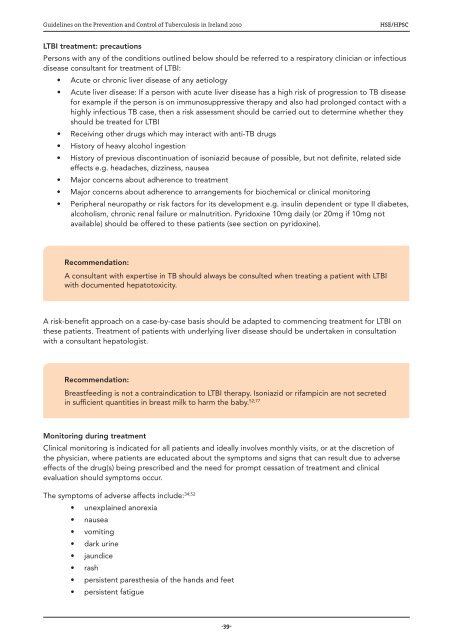Guidelines on the Prevention and Control of Tuberculosis in Ireland
Guidelines on the Prevention and Control of Tuberculosis in Ireland
Guidelines on the Prevention and Control of Tuberculosis in Ireland
Create successful ePaper yourself
Turn your PDF publications into a flip-book with our unique Google optimized e-Paper software.
<str<strong>on</strong>g>Guidel<strong>in</strong>es</str<strong>on</strong>g> <strong>on</strong> <strong>the</strong> Preventi<strong>on</strong> <strong>and</strong> C<strong>on</strong>trol <strong>of</strong> <strong>Tuberculosis</strong> <strong>in</strong> Irel<strong>and</strong> 2010HSE/HPSCLTBI treatment: precauti<strong>on</strong>sPers<strong>on</strong>s with any <strong>of</strong> <strong>the</strong> c<strong>on</strong>diti<strong>on</strong>s outl<strong>in</strong>ed below should be referred to a respiratory cl<strong>in</strong>ician or <strong>in</strong>fectiousdisease c<strong>on</strong>sultant for treatment <strong>of</strong> LTBI:• Acute or chr<strong>on</strong>ic liver disease <strong>of</strong> any aetiology• Acute liver disease: If a pers<strong>on</strong> with acute liver disease has a high risk <strong>of</strong> progressi<strong>on</strong> to TB diseasefor example if <strong>the</strong> pers<strong>on</strong> is <strong>on</strong> immunosuppressive <strong>the</strong>rapy <strong>and</strong> also had prol<strong>on</strong>ged c<strong>on</strong>tact with ahighly <strong>in</strong>fectious TB case, <strong>the</strong>n a risk assessment should be carried out to determ<strong>in</strong>e whe<strong>the</strong>r <strong>the</strong>yshould be treated for LTBI• Receiv<strong>in</strong>g o<strong>the</strong>r drugs which may <strong>in</strong>teract with anti-TB drugs• History <strong>of</strong> heavy alcohol <strong>in</strong>gesti<strong>on</strong>• History <strong>of</strong> previous disc<strong>on</strong>t<strong>in</strong>uati<strong>on</strong> <strong>of</strong> is<strong>on</strong>iazid because <strong>of</strong> possible, but not def<strong>in</strong>ite, related sideeffects e.g. headaches, dizz<strong>in</strong>ess, nausea• Major c<strong>on</strong>cerns about adherence to treatment• Major c<strong>on</strong>cerns about adherence to arrangements for biochemical or cl<strong>in</strong>ical m<strong>on</strong>itor<strong>in</strong>g• Peripheral neuropathy or risk factors for its development e.g. <strong>in</strong>sul<strong>in</strong> dependent or type II diabetes,alcoholism, chr<strong>on</strong>ic renal failure or malnutriti<strong>on</strong>. Pyridox<strong>in</strong>e 10mg daily (or 20mg if 10mg notavailable) should be <strong>of</strong>fered to <strong>the</strong>se patients (see secti<strong>on</strong> <strong>on</strong> pyridox<strong>in</strong>e).Recommendati<strong>on</strong>:A c<strong>on</strong>sultant with expertise <strong>in</strong> TB should always be c<strong>on</strong>sulted when treat<strong>in</strong>g a patient with LTBIwith documented hepatotoxicity.A risk-benefit approach <strong>on</strong> a case-by-case basis should be adapted to commenc<strong>in</strong>g treatment for LTBI <strong>on</strong><strong>the</strong>se patients. Treatment <strong>of</strong> patients with underly<strong>in</strong>g liver disease should be undertaken <strong>in</strong> c<strong>on</strong>sultati<strong>on</strong>with a c<strong>on</strong>sultant hepatologist.Recommendati<strong>on</strong>:Breastfeed<strong>in</strong>g is not a c<strong>on</strong>tra<strong>in</strong>dicati<strong>on</strong> to LTBI <strong>the</strong>rapy. Is<strong>on</strong>iazid or rifampic<strong>in</strong> are not secreted<strong>in</strong> sufficient quantities <strong>in</strong> breast milk to harm <strong>the</strong> baby. 52;77M<strong>on</strong>itor<strong>in</strong>g dur<strong>in</strong>g treatmentCl<strong>in</strong>ical m<strong>on</strong>itor<strong>in</strong>g is <strong>in</strong>dicated for all patients <strong>and</strong> ideally <strong>in</strong>volves m<strong>on</strong>thly visits, or at <strong>the</strong> discreti<strong>on</strong> <strong>of</strong><strong>the</strong> physician, where patients are educated about <strong>the</strong> symptoms <strong>and</strong> signs that can result due to adverseeffects <strong>of</strong> <strong>the</strong> drug(s) be<strong>in</strong>g prescribed <strong>and</strong> <strong>the</strong> need for prompt cessati<strong>on</strong> <strong>of</strong> treatment <strong>and</strong> cl<strong>in</strong>icalevaluati<strong>on</strong> should symptoms occur.The symptoms <strong>of</strong> adverse affects <strong>in</strong>clude: 34;52• unexpla<strong>in</strong>ed anorexia• nausea• vomit<strong>in</strong>g• dark ur<strong>in</strong>e• jaundice• rash• persistent pares<strong>the</strong>sia <strong>of</strong> <strong>the</strong> h<strong>and</strong>s <strong>and</strong> feet• persistent fatigue-39-
















